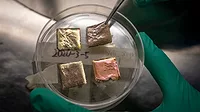Scientists Develop Coating That Prevents Ice Formation
LOS ANGELES – Materials scientists at the UCLA Samueli School of Engineering and colleagues in China have developed a coating that prevents ice from forming. The way it works is inspired by a natural mechanism that keeps blood from freezing in several species of fish that live near Antarctica.
Their study, which is published in Matter, suggests that the new coating could be an inexpensive and versatile solution for preventing critical parts on airplane wings, outdoor pipes and other equipment from freezing over in cold temperatures. It is the first material that prevents ice formation by acting on three distinct aspects of ice formation.
“Ice formation starts from nucleation, when a small seed crystal of ice first forms, before it grows and then finally adheres to a surface,” said Ximin He, who led the study and is a UCLA Assistant Professor of Materials Science and Engineering. “While there are anti-ice solutions out there, they’re designed to tackle only one of these three aspects of this complex process, or they only work on certain types of surfaces. This new coating is an all-in-one solution to prevent ice formation on many different surfaces, from plastics to metals to ceramics, and under different conditions.” He said the material is also simple to make and very durable.
The gel is made mostly of water, but its key ingredient is polydimethylsiloxane, a nontoxic, silicone-based polymer used in contact lenses, cosmetics, lubricants and other applications that require some slipperiness. When sprayed onto a surface, it forms a thin, transparent coat that helps prevent freezing in three different ways: lowering the freezing temperature of water on the surface, delaying ice crystals from growing and making the surface difficult for ice to stick to.
The researchers tested the coating on several materials, including plastic, glass, ceramics and metals. It set a record by preventing ice from forming until the temperature reached -31 °C (-23.8 °F). The previous record of -28 °C (-18.4 °F) was established in 2016 when a different coating was applied to silicon and glass. (The research group that conducted that study was led by Jianjun Wang of the Chinese Academy of Sciences in Beijing, who also was a co-author of the latest research.)
Water usually freezes around 0 °C (32 °F), although the precise freezing point depends on environmental conditions.
The hydrogel also set a record for the amount of time it delayed ice from forming at a temperature of -25 °C (-13 °F). In the study, materials including plastic, glass, ceramics and metals that were coated with the hydrogel took more than 65 minutes for ice to form at that temperature, more than 40 minutes longer than the previous record, which also was set during the 2016 study.
And even if ice does form on an object’s surface, the hydrogel coating makes it easy to remove the ice by simply brushing or blowing it off, without scraping the object or applying heat.
In the 1960s, scientists discovered that several species of Antarctic fish make proteins that work as an antifreeze for their bloodstreams. Similar proteins have since been found in insects, microorganisms and plants. The new coating works in part through mimicking the molecular structure of those proteins.
The researchers conducted much of the experiment in a laboratory, although one test was performed outdoors, in Beijing, at below freezing temperatures.
Looking for a reprint of this article?
From high-res PDFs to custom plaques, order your copy today!




